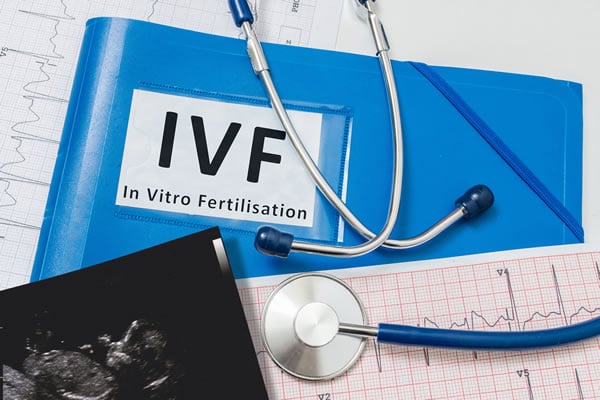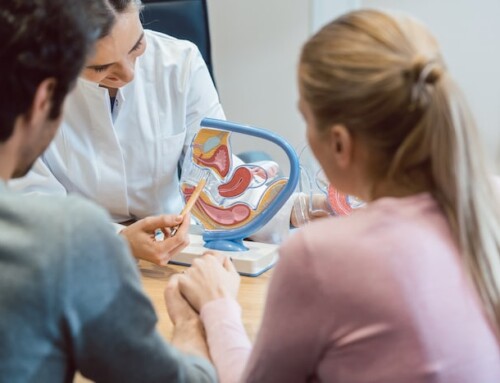For the millions of couples facing fertility issues in Europe, the UK, and the USA alone (12% of the global population), IVF has come as a light at the end of a long, dark tunnel, allowing them to fill their hearts with hope and begin dreaming of starting a family again. Indicatively, at the Cyprus IVF Centre, we have helped more than 9,000 women get pregnant and be able to sustain pregnancy after conception. And, to speak with percentages, our IVF success rate per attempt is remarkably high (>70%) and 3 times higher than what you can get in the UK, regardless of diagnosis!
But, what is In-Vitro Fertilisation or IVF treatment ?
Simply put, it is the most common form of Assisted Reproductive Technology that involves the fertilisation of one or more eggs outside the body and can be performed using either your own DNA, meaning your eggs and your partner’s sperm, or donated eggs and/or sperm. IVF is also the most effective treatment for the overwhelming majority of infertility types, even women with significantly damaged fallopian tubes and couples with seemingly sterile husbands.
Is IVF for You ?
- Have been suffering unexplained infertility.
- Have blocked or obstructed fallopian tubes.
- Were not successful with other techniques (i.e. fertility medications) or IUI (intrauterine insemination).
- Are using frozen eggs (their own) or donated eggs in the treatment.
- Require intra-cytoplasmic sperm injection (ICSI) to use their male partner’s sperm.
- Are using Pre-Implantation Genetic Diagnosis or PGD (embryo testing to avoid passing a hereditary or genetic condition to the child).
How Does it Work ?
In Brief:
The eggs are harvested from the patient and are then fertilised in our state-of-the-art laboratory. About 2-5 days later, the resulting embryos are placed into the uterus. The remaining embryos can be frozen using vitrification and saved for future use without worrying about them experiencing any damage. This means that the success rate for frozen embryos, at least at the Cyprus IVF Centre, is almost as high as for IVF treatments where we use fresh embryos.
In More Detail:
With the use of an ultrasound-guided needle (no surgical incisions and literally no pain afterward), the eggs are retrieved under light sedation, in the operating room. After the egg retrieval procedure, you can leave the clinic feeling minimal to no discomfort at all. Three to five days later, you come back for the embryo transfer process, where our doctors places the embryos into your uterus through the cervix with the very small catheter and, after a two hour rest in your private bedroom, you are ready to go home with detailed instructions as to how and when you can go back to your routine schedule and activities, by our doctors. It is a totally pain-free procedure that is done without any anaesthesia and involves no incisions either.
To make sure a patient is ready for the egg retrieval, Team Miracle carefully monitor her ovaries after she is prescribed injections with hormones to stimulate them. With blood tests every day or every couple of days, depending on the case, and with the help of ultrasound, we identify the perfect time to proceed with the procedure.
Some women find this phase a bit intimidating, especially if it’s their first time undergoing an IVF treatment. However, we are all here to support and gently guide you through this so don’t hesitate to ask us anything you feel burdening you.
Here is a breakdown of what’s involved for women when undergoing IVF:
1. Suppression of the Monthly Hormone Cycle
In general, we prefer not to use any form of down regulation medication. Poor responders tend to have better outcomes when placed on short protocols. Therefore, we usually wait until day 2 of your natural cycle before starting stimulation.
2. Increase Egg Supply
On day 2 or 3 of the cycle, our doctors will start you on a gonadotropin, a type of fertility hormone that you take as a daily injection for 10-12 days. This will grow the antral follicles in your ovaries so that we can hopefully achieve a higher number of mature eggs.
When the time comes, we will help the eggs mature with a hormone injection given about 36 hours before the eggs are due to be collected. Meanwhile, we will monitor your daily progress through ultrasound scans (vaginal) and, sometimes, blood tests (if necessary).
3. Egg Collection
Always with ultrasound guidance and a tiny, hollow needle attached to the ultrasound probe, your eggs will be carefully collected from your ovaries (the follicles on each one) while you are sedated. After harvesting the eggs, we need to prepare the lining of the womb for the upcoming embryo transfer. We need to make sure it will be strong enough to support a pregnancy. For that reason, you will be given a variety of other medication to start after the egg collection.
4. Egg Fertilisation
Now it’s time to ask for a sperm sample from your partner so we can mix it with the eggs we have retrieved and fertilise them in our laboratories that are equipped with the latest technology in assisted reproductive medicine and highly advanced incubators that ensure the developing embryos are in a safe, secure environment until they are mature enough to be transferred into the mother’s uterus (usually day 3 or 5 after fertilisation). Our expert embryologists will monitor the development of the embryos round the clock and select the best ones for transfer. The remaining embryos can be frozen if their quality allows it, for future use if you so wish.
Note: If your partner’s sperm is poor or we detect low sperm count or motility, we have the IMSI microscope available to increase the chance of successful fertilization. If there are no sperm present at all, you can always consider using donor sperm.
5. Embryo Transfer
Usually, our doctors chooses to transfer two embryos if the patient is in her 30s. For women over 40, she may transfer three or four embryos. At this point, it should be noted that because transferring 2+ embryos is related to multiple pregnancy and we are making an effort to cut the rate of multiple pregnancy.
That said, the procedure will feel much like having a cervical smear taken. When the embryos are transferred into the uterus through a fine catheter (tube) that is passed through the cervix with ultrasound guidance, you can heave a sigh of relief as you now enter the next stage; that of the 2-week-wait period, at the end of which you can have a pregnancy test!
The only discomfort you may feel during the procedure could be related to the fact that we need a full bladder to perform the ultrasound.
Note: Some women (about 1% of those undergoing an IVF treatment) may over-react to the ovary-stimulation hormone medications. However, we are able to foresee it and avoid any risk involved, so you have nothing to worry about.
For any concerns or questions, please don’t forget that we are here to help any way we can. Our Patient Coordinators, as well as knowledgeable and compassionate medical staff, can provide all the support you need and walk this road with you until you have your wish to start a family soon granted!
Let’s talk about the various IVF treatments to find out the best one for your case. No matter the fertility issue you may be facing, rest assured we will figure things out.






